Introduction
Ali Aye Ligang is one of the most significant festivals of Assam, celebrated with great enthusiasm by the Mising community. This festival marks the beginning of the sowing season and reflects the deep-rooted agricultural traditions of the Mising people. It is observed on the first Wednesday of the Assamese month of Phagun (February–March), a time when farmers start cultivating Ahu rice, a variety of summer paddy.
Meaning and Significance
The name Ali Aye Ligang holds a deep symbolic meaning:
- Ali – Seeds
- Aye – Fruits
- Ligang – Sowing
The festival is a tribute to agriculture, nature, and the cycle of life. It is an occasion to seek blessings from the gods for a prosperous harvest and to honor the hard work of farmers.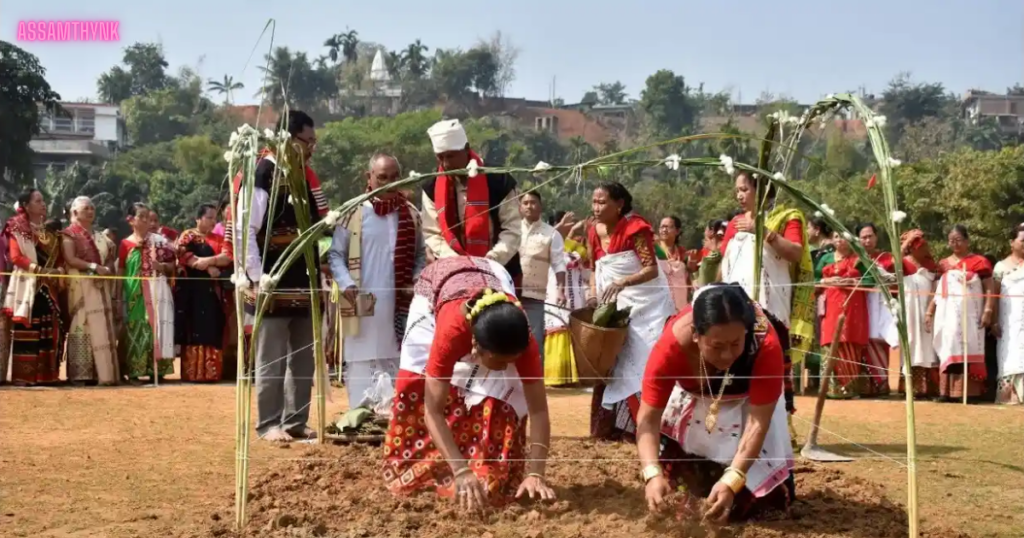
Ali Aye Ligang is more than just a festival; it is a reflection of the bond between nature and mankind. The Mising community, known for their deep connection with the environment, considers this festival sacred. The rituals performed during the festival have been followed for centuries, passed down through generations, and continue to be an essential part of their cultural heritage.
Traditional Celebrations
Ali Aye Ligang is celebrated with a mix of rituals, traditional dances, and community feasts. Some of the key highlights include:
1. Ritualistic Sowing
On this auspicious day, the eldest members of the family perform the ceremonial sowing of seeds in their fields, symbolizing the beginning of the farming cycle. This ritual signifies the hope for a bountiful harvest and marks the formal start of agricultural activities for the year.
2. Gumrag Dance and Music
A major attraction of the festival is the Gumrag dance, performed by young men and women in colorful traditional attire. This dance, accompanied by folk music played on instruments like dhol, pepa, and taal, creates a festive atmosphere. The dance is not just for entertainment but is also a way of paying homage to nature and celebrating the new season.
During the dance, the movements symbolize various aspects of agriculture, such as planting, harvesting, and celebrating the yield. The rhythmic beats and synchronized steps make the Gumrag dance an integral part of the festival.
3. Community Feast
Food plays a vital role in Ali Aye Ligang celebrations. Some of the traditional delicacies include:
- Purang Apin – Rice wrapped in leaves and steamed.
- Fish and pork dishes – Cooked with local herbs and spices.
- Apong – A traditional rice beer, brewed by the Mising people and enjoyed during the festival.
The feast is a grand affair, where people from different villages and communities come together to celebrate. It is a time for bonding and sharing, where elders pass down stories and knowledge to the younger generation.
4. Avoidance of Agricultural Activities
As a mark of respect for the festival, agricultural activities like plowing, cutting trees, or fishing are strictly avoided on this day. This tradition signifies a break from hard labor, allowing the community to come together and enjoy the festivities without any distractions.
Cultural Importance
Beyond agriculture, Ali Aye Ligang is a celebration of Mising culture and unity. It brings together people from different villages and towns, strengthening community bonds. The festival also showcases the rich traditions, attire, and crafts of the Mising community, contributing to the cultural heritage of Assam.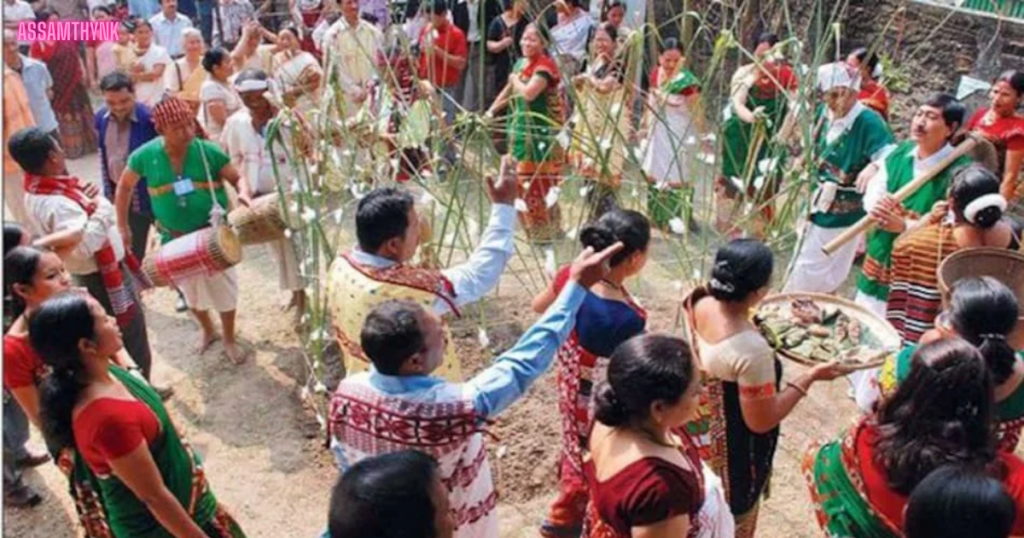
During the festival, traditional attire is worn by men and women. The women wear Ribi Gaseng, a colorful handwoven cloth, while the men wear Mibu Galuk, a traditional tunic. The vibrant outfits add to the festive spirit, making the celebrations even more visually appealing.
Activities of Ali Aye Ligang
Ali Aye Ligang is celebrated with various traditional and cultural activities that reflect the Mising community’s rich heritage. The festival begins with the ceremonial sowing of seeds, marking the start of the agricultural cycle. The highlight is the Gumrag dance, performed in groups with rhythmic steps and folk music using dhol, pepa, and taal. Community feasts feature traditional dishes like Purang Apin, fish, pork, and Apong (rice beer). People avoid agricultural work on this day as a sign of respect. Modern celebrations include cultural competitions, exhibitions, and social gatherings, spreading awareness of Mising traditions.
Modern-Day Celebrations
Ali Aye Ligang is not just limited to Mising villages but is also celebrated in urban areas, including Guwahati and other towns in Assam. Various cultural programs, folk performances, and food festivals are organized, attracting people from all communities. The festival serves as a platform to promote Mising heritage and Assamese culture at a broader level.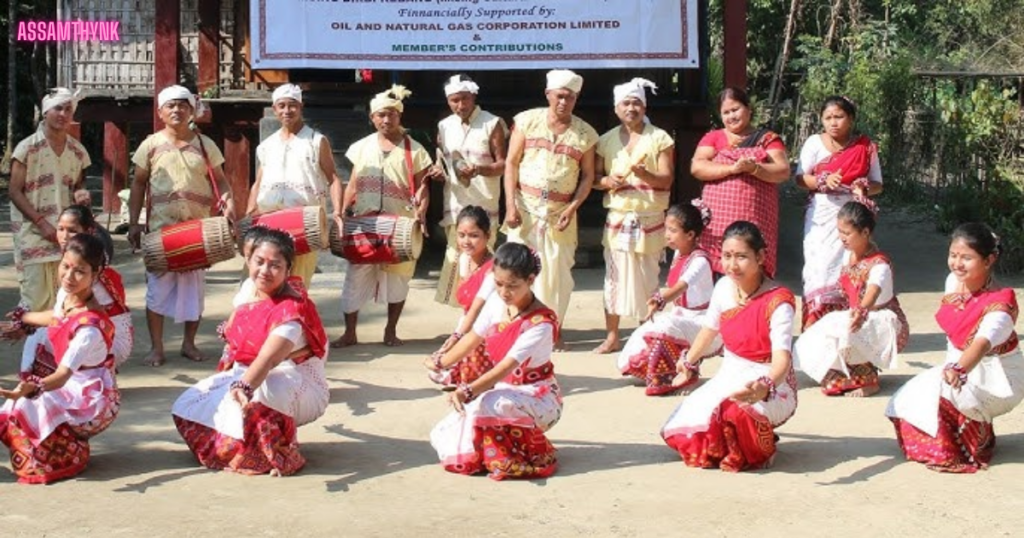
Educational institutions and cultural organizations also play an essential role in keeping the traditions of Ali Aye Ligang alive. Schools and colleges conduct programs to educate students about the significance of the festival, ensuring that the younger generation remains connected to their roots.
Additionally, with the rise of social media, the festival has gained more visibility. Videos and pictures of the celebrations are shared widely, helping spread awareness about the rich traditions of the Mising people beyond Assam.
Historical Origins and Evolution
Ali Aye Ligang has its roots in the agrarian lifestyle of the Mising community. Historically, the festival was observed in small villages, with simple yet meaningful rituals. Over time, as the Mising people migrated to different parts of Assam, they carried their traditions with them, leading to the widespread celebration of Ali Aye Ligang across the state.
Despite modern influences, the core traditions of the festival have remained intact. Efforts by cultural organizations and the Mising Autonomous Council have helped preserve the authenticity of the festival while also adapting certain aspects to contemporary times.
Significance of Music and Dance
Music and dance are integral parts of Ali Aye Ligang, serving as a medium to express joy and gratitude. The Gumrag dance is the most prominent dance form, characterized by energetic movements and synchronization. It is performed in an open area, often around a fire, symbolizing the connection between humans and nature.
The instruments used during the festival include:
- Dhol – A traditional drum that sets the rhythm for the dance.
- Pepa – A flute-like instrument made from buffalo horn, producing melodious tunes.
- Taal – Small cymbals that add a rhythmic element to the music.
The songs sung during Ali Aye Ligang are mostly folk songs, narrating tales of agricultural prosperity, love, and nature. These songs have been passed down through generations and hold deep cultural significance.
Tourism and Economic Impact
Ali Aye Ligang has also contributed to the tourism industry in Assam. The festival attracts travelers and cultural enthusiasts who are keen to witness the unique traditions of the Mising community. Special cultural events, exhibitions, and fairs are organized to showcase Mising art, crafts, and cuisine.
The increased attention on Ali Aye Ligang has also provided economic opportunities for local artisans. Handwoven textiles, bamboo crafts, and traditional jewelry see a rise in demand during the festival. This has encouraged more people to take up traditional crafts, ensuring their survival in the modern era.
Festivals of the Mising Community
The Mising community, one of the major ethnic groups of Assam, celebrates several vibrant festivals that reflect their deep connection with nature, agriculture, and cultural heritage. The most significant festivals include Ali Aye Ligang, Porag, and Dobur Uie.
Ali Aye Ligang
Ali Aye Ligang is the most important festival of the Mising people, marking the beginning of the sowing season. Celebrated in February–March, it involves traditional Gumrag dance, folk music, and community feasts featuring Purang Apin (rice wrapped in leaves) and Apong (rice beer). Agricultural work is avoided on this day as a mark of respect.
Porag
Porag is a post-harvest festival that celebrates prosperity and unity. It features grand feasts, cultural performances, and traditional sports. The festival strengthens community bonds and showcases Mising traditions.
Dobur Uie
Dobur Uie is a religious festival where the Mising people pray to deities for protection and well-being. Ritual sacrifices and prayers are performed to ensure prosperity and ward off evil.
Unity and Modernization in Ali Aye Ligang
Ali Aye Ligang, the vibrant festival of the Mising community, symbolizes unity and cultural pride. It brings people together, strengthening bonds through traditional Gumrag dance, feasts, and rituals. While rooted in agricultural traditions, modernization has influenced its celebrations. Today, the festival extends beyond villages to cities, with cultural programs, digital promotions, and tourism initiatives. Social media and urban events have helped preserve and promote Mising heritage. Despite modernization, the core values of unity, gratitude, and reverence for nature remain intact, ensuring that Ali Aye Ligang continues to be a bridge between tradition and progress.
Top 10 FAQs About Ali Aye Ligang
1. What is Ali Aye Ligang?
Ali Aye Ligang is an important agricultural festival of the Mising community in Assam, marking the beginning of the sowing season for Ahu rice.
2. When is Ali Aye Ligang celebrated?
It is celebrated on the first Wednesday of Phagun (February–March), according to the Assamese calendar.
3. What is the meaning of Ali Aye Ligang?
The name symbolizes agriculture:
- Ali – Seeds
- Aye – Fruits
- Ligang – Sowing
4. How is Ali Aye Ligang celebrated?
The festival includes ritualistic seed sowing, traditional Gumrag dance, folk music, community feasts, and avoidance of agricultural work for the day.
5. What is the significance of the Gumrag dance?
The Gumrag dance symbolizes prosperity and gratitude towards nature. It is performed with rhythmic steps and traditional musical instruments.
6. What food is prepared during Ali Aye Ligang?
Traditional Mising dishes like Purang Apin (rice wrapped in leaves), fish, pork dishes, and Apong (rice beer) are enjoyed.
7. Why is agricultural work avoided on this day?
Plowing, fishing, or tree cutting is prohibited as a mark of respect for the festival and nature.
8. How has Ali Aye Ligang evolved over time?
With modernization, celebrations have expanded to urban areas with cultural programs, exhibitions, and digital promotions to spread awareness.
9. Where is Ali Aye Ligang celebrated?
It is mainly celebrated in Mising villages across Assam and Arunachal Pradesh, but also in cities like Guwahati and Dibrugarh.
10. Can tourists experience Ali Aye Ligang?
Yes! Tourists are welcome to witness traditional dances, food, and cultural events, making it a great way to experience Mising heritage.
Conclusion
Ali Aye Ligang is more than just an agricultural festival—it is a celebration of life, nature, and tradition. Rooted in Assam’s agrarian culture, it reminds us of the importance of sustainable farming and community harmony. As the Mising people continue to preserve their customs, this festival remains a testament to their resilience and love for nature.
The festival is not only a reminder of Assam’s rich heritage but also an invitation for everyone to experience the warmth and hospitality of the Mising community. Whether you are a traveler, a culture enthusiast, or simply someone who appreciates traditional festivities, Ali Aye Ligang is an event that should not be missed.

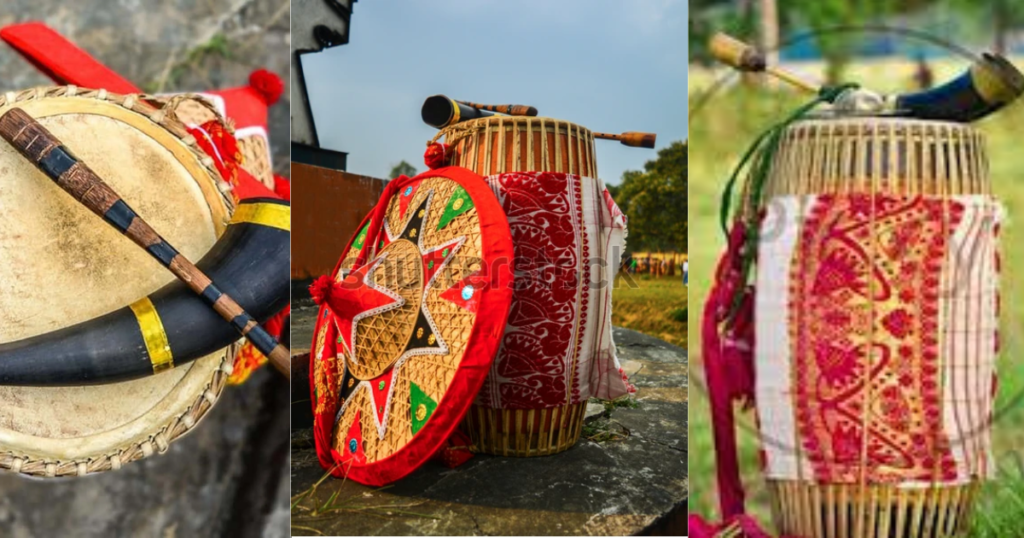

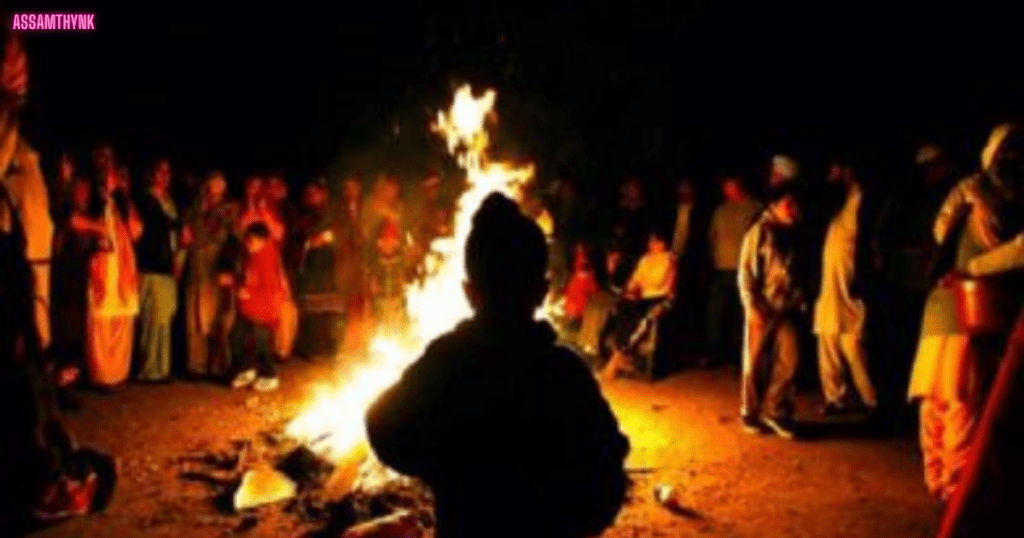
I’m really impressed together with your writing skills and also with the layout for your weblog. Is this a paid theme or did you customize it yourself? Anyway stay up the nice high quality writing, it’s uncommon to peer a nice blog like this one these days!